The Need
As Indiana’s population ages, it is projected that there will be a dramatic shift in the demographics of the state. The oldest Baby Boomers reached age 65 in 2011, and by 2030 one in five older adults will be of traditional retirement age. [1] Rapid increases in the older adult population will dramatically increase the need for services and supports of the aging population and attention to equity-related issues faced by older adult subpopulations.
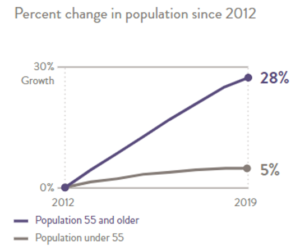
- In 2019, older adults (age 55 and older) composed one quarter (25%) of the Central Indiana population. [2]
- Between 2012 and 2019, the number of older adults increased by 28%, while the population under age 55 increased by only 5%.
- While people of color comprise one in six older adults, one third of those under 55 are people of color. This more diverse younger population will result in an increasingly diverse older adult population in the future.
The Central Indiana Senior Fund provides support to not-for-profit organizations whose programs and services promote quality living for older adults in Central Indiana. It is specifically interested in organizations that address the following areas of interest:
Basic Needs
The basic needs of older adults include access to nutritious food, transportation services, emergency services and shelter, case management, elder violence reduction, and local guardianship programs.
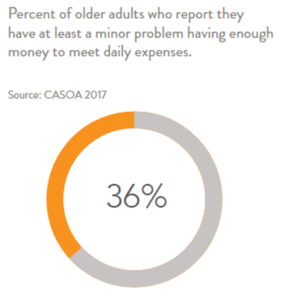
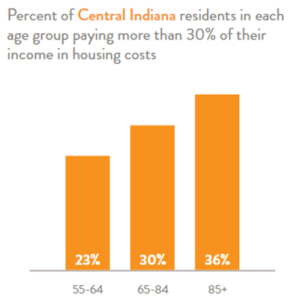
- While household income increased among older adults in Central Indiana between 2014 and 2019, one in 12 older adults experiences poverty, with the greatest poverty rate among those 85 and older.
- Black and Latinx older adults are more likely to experience poverty than White older adults, and older women are more likely to experience poverty than older men.
- According to older adults and service providers, the chief barriers to food access and security are transportation and money.
- More than half of older adults who rent their homes in Central Indiana are housing cost-burdened, spending at least 30% of their income on housing costs.
- Perceptions of community safety among older adults in Central Indiana have increased [3] but vary among older adults living in high-crime neighborhoods.
- Older adults in rural areas have less access to transportation options, due to lack of resources for rural transportation systems, changing demography resulting from movement from rural to urban areas and limited Medicare support for transportation to medical appointments.
Health and Wellness
Good health and wellness among older adults requires access to health education; intervention services for older adults, in-home health care, prevention and screening; and outcome-based neighborhood community wellness and fitness programs.
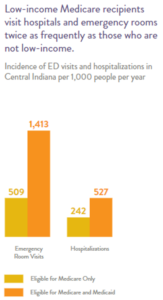
- As of 2019, cancer remains the leading cause of death for those age 55 to 84. Heart disease is the leading cause of death for those 85 and older. Deaths from falls, drug overdose and suicide have increased in Central Indiana older adults over time, matching state and national trends. [4]
- Providers identify falls and the fear of falling, mental health and emotional issues, dementia and fragmented care as issues that need more resources and attention.
- Six healthcare systems in Central Indiana have been recognized by the Institute for Healthcare Improvement as Age-Friendly Health Systems. However, rural areas still lack specialized geriatric healthcare services.
- Low-income and other vulnerable Medicare recipients in Central Indiana visit hospitals and emergency rooms more frequently than other Medicare recipients. [5]
Living Environment of Choice
Empowering adults to grow older where they choose requires establishing and maintaining affordable and supportive housing for older adults, providing home care and maintenance services that enable older adults to safely remain in their homes, promoting projects that increase neighborhood safety, and supporting efforts to strengthen and enhance quality residential care programs for low-income older adults.
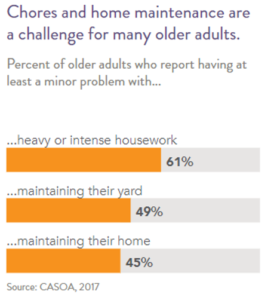
- Most older adults in Central Indiana believe their communities are a good place to live, and four in five intend to remain in them throughout retirement. [6]
- Three in five older adults report difficulty maintaining their homes, both inside and out.
- Two-thirds of older adults report not knowing about necessary services to assist them with remaining in their homes and communities as they age.
- Approximately three in five Central Indiana households with older adults report access to community activities, but fewer than one in five reports participation in community activities, suggesting low inclusion.
- In Indiana, disability is one of the biggest contributors to isolation in older adults.
- It is difficult for providers to find or reach isolated older adults.
Life-Affirming Opportunities
Opportunities for older adults to utilize their talents and resources is important to improving their overall quality of life. These opportunities include increased access to cultural and education opportunities, work training and job placement, life-long learning, civic engagement, and social and recreation activities that increase social interaction.
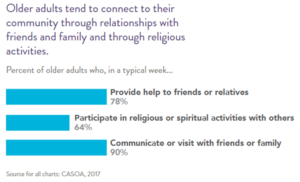
- About one in three older adults in Central Indiana reports feelings of loneliness or social isolation, and this is likely more prevalent among older adults experiencing poverty. [7]
- Nearly one fifth of adults of traditional retirement age continue to work outside the home.
- Four out of five older adults in Central Indiana provide care to a friend or loved one, and two in five provide care to someone over the age of 60. [8]
[1] Rachel Strange, “Indiana’s Elderly Population Projected to Climb Sharply,” August 2018, http://www.incontext.indiana.edu/2018/july-aug/article2.asp
[2] U.S. Census Bureau, Public Use Microdata Sample, American Community Survey 2015-2019 five-year estimates. Unless otherwise specified, this is the source for all statistics mentioned on this page.
[3] National Research Center, “CICOA Aging and In-Home Solutions Full Report,” Community Assessment Survey for Older Adults (TM), 2017, https://cicoa.org/wp-content/uploads/2019/11/Indiana-CASOA-Report-2017-FINAL.pdf
[4] Centers for Disease Control and Prevention, WONDER
[5] Centers for Medicare and Medicaid Services
[6] National Research Center, 2017. Living environment of choice data originates from the CASOA survey.
[7] National Research Center, 2017
[8] National Research Center, 2017




